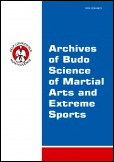2023, Volume 19, Issue 1
Differentiation of somatic and efficiency indicators as a sign of athletes` adaptation to efforts of various nature
Jakub Jelonek1, Marek Kruszewski2, Artur Kruszewski2, Rafał Tabęcki2, Karol Pilis1, Stanisław Kuźmicki2
1Department of Health Sciences, Jan Długosz University in Czestochowa, Czestochowa, Poland
2Department of Individual Sports, Jozef Pilsudski University of Physical Education in Warsaw, Warsaw, Poland
Author for correspondence: Artur Kruszewski; Department of Individual Sports, Jozef Pilsudski University of Physical Education in Warsaw, Warsaw, Poland
Full text
Abstract
Background & study Aim: The problem of the work is to search for the relationship between the type (character) of professional training used and the differences in the values of somatic and efficiency indicators of athletes. The aim of the study is knowledge about the diversity of somatic features, body composition and anaerobic power of professional athletes of heterogeneous sports disciplines and students of physical education.
Material & Methods: The study included athletes with second or higher sports classes in the following disciplines: long distance runners (n = 12), powerlifting (n = 12) and martial arts – taekwondo and Brazilian jiu-jitsu (n = 12). Students of physical education (n = 12) constituted the control group. Somatic measurements were made using the Tanita Body Composition Analyzer TBF-300 (Japan). Anaerobic capacity was measured using the Wingate 30 s test on an Excalibur Sport cycloergometer.
Results: Participants of the study differed in such somatic and body composition variables as: body weight, fat content, lean body mass, water content in the body. Intergroup differences in the amount of work done [W], average power [Pmean] and maximum power [Pmax], recorded during the Wingate test, were indicated. A relationship was found between the value of performance and somatic variables and the type of sport practiced.
Conclusions: Applied sports training of various nature can cause significant changes in the bodies of athletes. Physiological and somatic variables can be identifiers indicating different levels of sports preparation of the examined people.
Key words: powerlifting, physical efficiency, martial arts, long distance athletes, physiology, training





